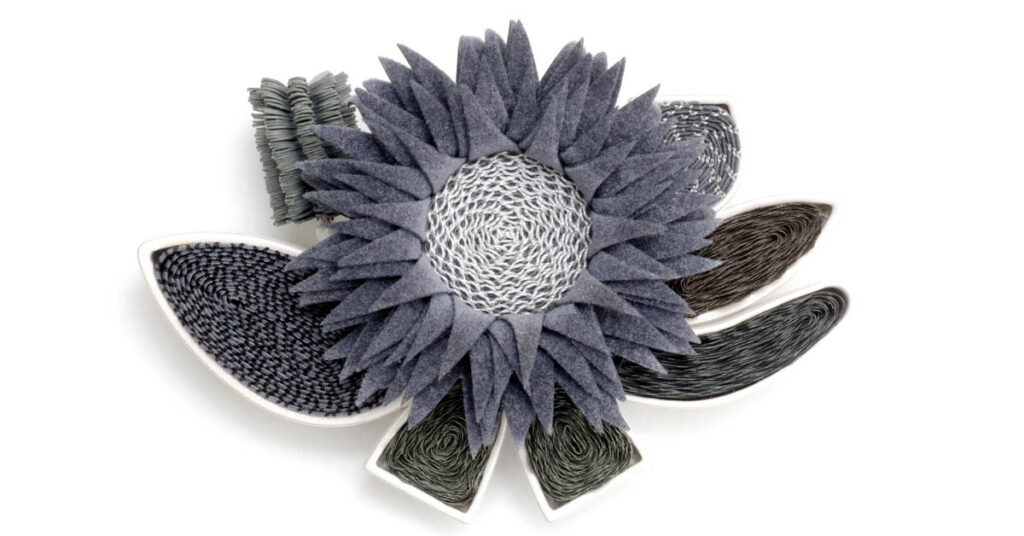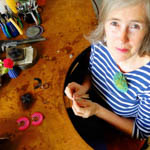
Vicki Mason, Composite bouquet, 2011 Powdercoated brass, PVC, sterling silver polyester, rayon and viscose thread, H55xW80xD18mm. Photo – Andrew Barcham
“Plastic … is in essence the stuff of alchemy”
Roland Barthes, Mythologies (1957)
Vicki Mason seeks to realise the beauty of plastic in ornaments that will endure.
I have an enduring fascination with plastic that is a result of a childhood spent growing up with plastic objects made in the 1970s. Pop-coloured glossy kitchen plates, acrylic and resin rings and shiny vinyl records pressed in rainbow hues bewitched me. I make contemporary jewellery and plastic is a material that enchants me and I’ve used many forms of it in my work over 24 years of making.
The height of my use of “synthetics” happened a dozen or so years ago while studying for a Master’s degree (research) at ANU in Canberra. I initially trained as a jeweller with metal being my singular medium, but I have always been open to using other materials. The work Composite bouquet, a metal and plastic brooch from that time, takes a bouquet form inspired by a colonial bouquet brooch made by migrant jewellers Hogarth, Erichsen & Co. in c1858, which is held in the Powerhouse Museum in Sydney. At the time I was revisiting traditional forms of jewellery, but from a contemporary perspective to offer up something new. My piece is made up of an ornamental vocabulary of plant-based forms that I developed. These forms were inspired by research into indigenous plants found in Australian colonial jewellery, chinoiserie plant motifs used on Mason’s ironstone china wares and forms based on local endemic plants from the southeast of Naarm (Melbourne) where I live. Melding these very different strands of research was a way of embracing the decorative potential of plant forms of Australian and imported origin to tell a personal story about migration, identity, hybridity and belonging.
I found it a perfect foil to the rigidity of metal
In this bouquet brooch, the material that sits within the white cake tin-like metal casings is flexible PVC sheeting. Sourced as remnant material from the stationery industry, I investigated its qualities, workability and spirit for ten years. I found it a perfect foil to the rigidity of metal and it enabled me to extend my learning and mode of working as I pushed and pulled it to create and innovate. Amongst a myriad of processes explored, I stitched it using a sewing machine, dyed it, stamped it, coiled it, printed onto it and folded it like paper.
Alongside the PVC, the brooch features black and white polyester, rayon and viscose threads, and the white surface on the cast brass casings is powder-coated polyester. Powdercoating creates a coloured uniform surface that I used and still use as a counterpoint to more textural elements in my work.
Rather than treating this material with contempt, as disposable and lesser, I’ve attempted to elevate the plastics I’ve used.
I don’t use as much plastic in my work these days, but I still think of plastic as a material that embodies the idea of contemporary magic. It’s a crafted material made in a laboratory with its own unique properties and aesthetic qualities. For me, plastic is a little rebellious It has no indigenous character to be true to and goes against the concept of the “truth to materials” doctrine. It’s a material from my time, democratic and complex. I value that it has allowed me to build material knowledge that sits outside the ancient elements craft is so often closely aligned with. It has helped me build my material vocabulary, enabling me to discover and know the world a little better. Rather than treating this material with contempt, as disposable and lesser, I’ve attempted to elevate the plastics I’ve used. I want them to be perceived as valuable and precious and for wearers to want to engage with and care for them, all with the aim of shifting our relationship to this seemingly ordinary material.
My encounter with how plastic is valued shifted when I looked at it from other frames of reference, namely the worlds of museum and art gallery professionals. As I’ve come to learn more about the changing nature of these materials in relation to their lifespan, longevity and stability, I’ve come to ponder various aspects of my work I had not considered to the degree I do now.
We know plastic exists as a global waste burden, polluting the environment and remaining as a solid waste. Plastics don’t break down easily but in the art and museum worlds, and especially for conservators and object curators, they are mostly considered non-permanent materials as many degrade and change over time. The sheer range of plastics available and used to make craft and art means that their preservation constitutes a significant challenge for the conservation profession. The degradation of plastic objects in collections has been a growing problem for museums and galleries, yet the problem still confounds conservators and collectors due to the potential for rapid and often spectacular disintegration of objects with very little advance warning.
Different plastics break down at different rates. Common signs of deterioration include brittleness, crumbling, breaking, chipping, pitting, scratching, chalking, discolouration, crazing, cracking, staining, sweating, warping, shrinking and becoming sticky as plasticisers migrate out of the bulk material onto their surfaces. Questions about what constitutes a loss of quality apply to all materials. Changes in surface colour, gloss or the texture of oil paint, metals and stone, for example, are described as patina and are valued as a measure of age and authenticity. But for conservators, this same phenomenon in plastics is regarded negatively as degradation. Which leads me to ask, will there be an eventual appreciation for aged plastic? I guess time will tell.
As I’ve become more plastic literate I’ve moved away from using certain types. I don’t have to know everything about them but I do have a more considered view on the intended lifespan and durability of my jewellery that features synthetics. I’ve learnt the main factors initiating plastic degradation and deterioration are light, heat, oxygen and water. To maintain plastic over time the general rule is to keep it cold, dry, in the dark, away from pollutants (including solvents) and (in some cases) away from oxygen.
The stability and lifetime of any plastic in a jewel and how it ages over time may not be of concern to everyone, however, I invest a lot of time and thought in my work and feel a duty of care to those who have bought work that it last as long as it can. “Care Instructions” go out with my jewellery where plastic features. At a practical level, I’m willing to replace synthetic elements and repair works where possible. Once I have fallen off my perch if anyone wanted to employ a conservator to maintain a work then replacing any degraded plastic materials with an equivalent type is all good.
I’ll continue to stay critically engaged and in dialogue with this transformative medium and no doubt plastic will continue to, as Susan Lambert states in her book Provocative Plastics, “provoke strong opinions based on an uneasy mix of emotion, experience and knowledge”. Composite bouquet, with its many plastic elements, is housed in the Powerhouse Museum in Sydney, probably under optimal conditions where the vicissitudes of time are held at bay to some extent. But like all art objects, it is not immune to the inevitability, (whether rapidly or slowly) of death.
Further reading
Sam Kean, When Plastics are Precious.
Susan Lambert (Editor), Provocative Plastics: Their Value in Design and Material Culture, 2021, Springer Nature, Switzerland
Yvonne Shashoua, Conservation of Plastics, Routledge, 2008
About Vicki Mason
 Vicki Mason is a jeweller who lives and works in Naarm (Melbourne). Her interest in jewellery stems from a belief that jewellery has the capacity to provoke a viewer to respond or interact with a worn jewel, and therefore the wearer. A dialogue is opened up—jewellery then acts not only as a portable tool for the communication of ideas but as a social object. Vicki is interested in unpacking our relationship with plants within the contemporary context to build knowledge and raise awareness about the natural world in a technologically focused age. Visit www.vickijewel.com.
Vicki Mason is a jeweller who lives and works in Naarm (Melbourne). Her interest in jewellery stems from a belief that jewellery has the capacity to provoke a viewer to respond or interact with a worn jewel, and therefore the wearer. A dialogue is opened up—jewellery then acts not only as a portable tool for the communication of ideas but as a social object. Vicki is interested in unpacking our relationship with plants within the contemporary context to build knowledge and raise awareness about the natural world in a technologically focused age. Visit www.vickijewel.com.

